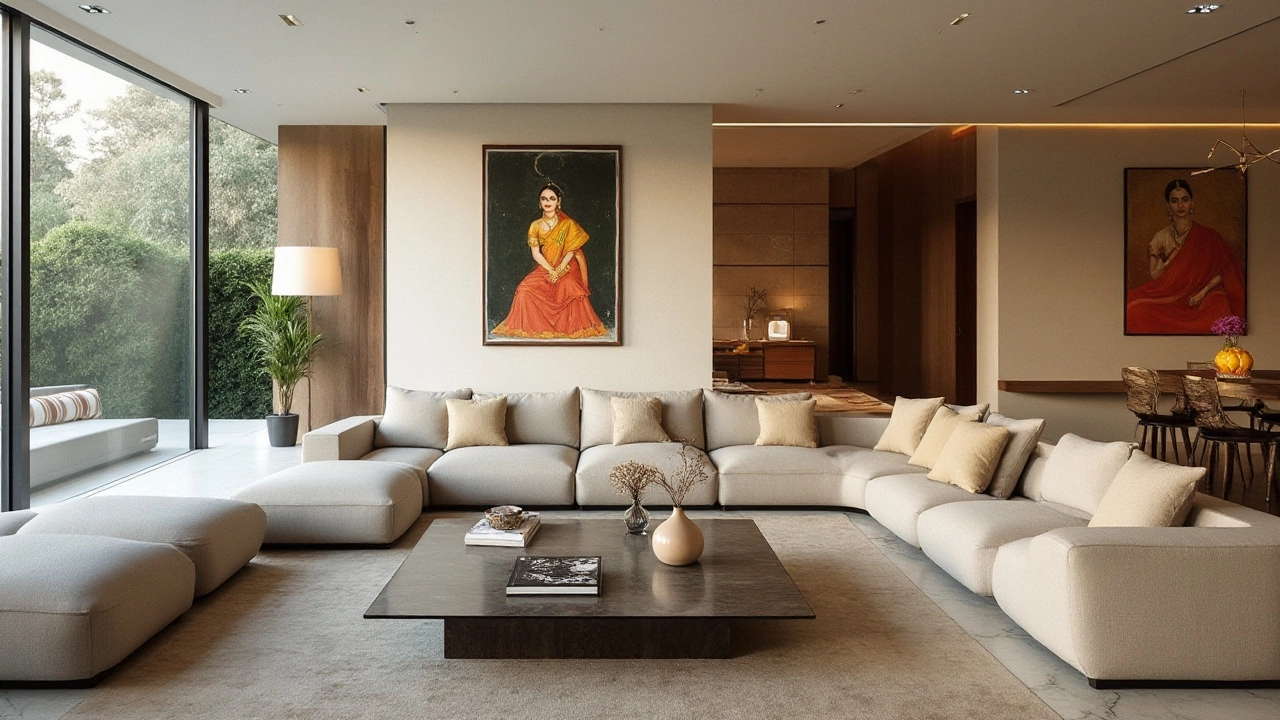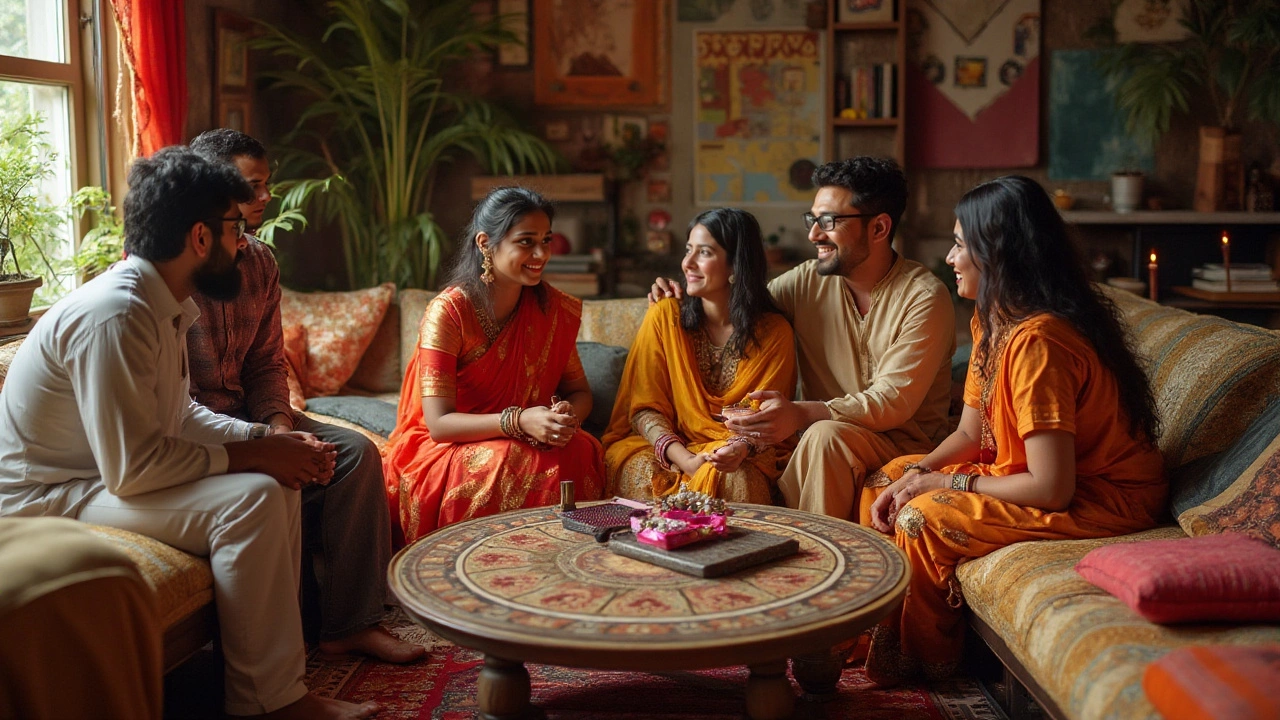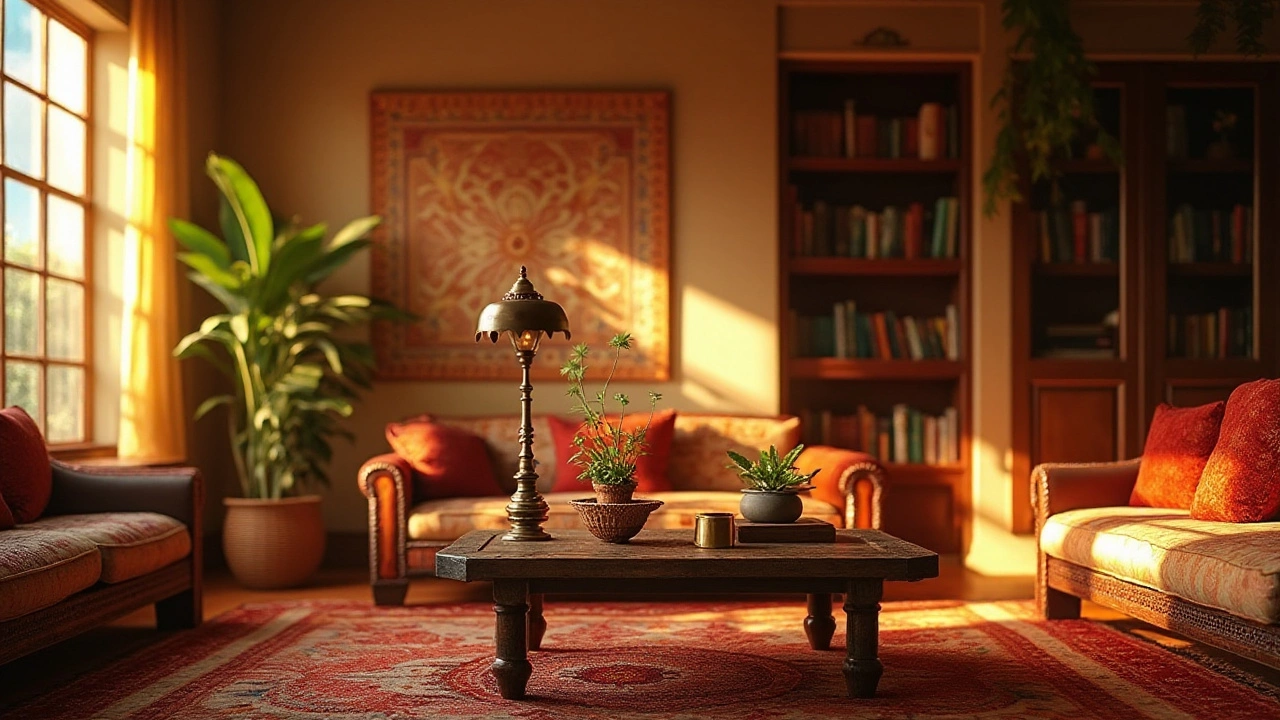Picture this: your living room, the centerpiece of your home where you gather with friends, dive into gripping stories, or find solace in its cozy corners. Amidst the plush seating and ambient lighting rests a humble hero — the coffee table. It holds your steaming cup, your enticing reads, and your late-night snack.
But, where should this noble piece call home? The answer isn't as simple as you'd think. Whether your aesthetic leans modern, rustic, or eclectic, the coffee table should reflect the personality of the room while offering practicality. Together, let's explore the world of coffee table placement — a journey that balances art and utility, enhanced by insightful tips to discover the ideal spot for this cornerstone of comfort.
- Understanding the Role of a Coffee Table
- Room Size and Shape Considerations
- Balancing Aesthetics with Functionality
- Complementing the Seating Arrangement
- Style and Design Influences
- Practical Tips for Optimal Placement
Understanding the Role of a Coffee Table
The coffee table is a fixture that has a presence in many living rooms. While we might unconsciously place our feet or pile magazines on it, its role is more significant than meets the eye. Think of it as the bridge between style and functionality. In rooms either sprawling or snug, it acts as the anchor, bringing visual balance and practical utility. It's a place where conversations begin, cups are shared, and memories sometimes unfurl. While its main task might be to support objects, its true calling extends to creating a sense of harmony.
If you were to ask an interior designer, they'd emphasize how this piece acts as a central part of your living room layout. Its placement guides flow and defines boundaries without erecting walls. From an aesthetic viewpoint, it echoes the room's motifs, whether they whisper or shout, and effortlessly ties disparate elements together. From a user's perspective, it plays host to myriad activities. Whether it's the backdrop for a solitaire game or the canvas for a child's imaginative sculptures, its intimate proximity to seating areas extends its usability far beyond the aesthetic.
Positioned amidst couches and armchairs, the coffee table carves out an inviting spot to rest a weary arm or idle feet during movie nights. Additionally, its height is meticulously chosen to ensure comfort and accessibility, making the stretch for the remote more convenient, the reach for the mug effortless. Notably, the height often parallels the seat cushion's, maintaining an unobstructed view of the room’s visual highlights. According to the International Interior Design Association, the coffee table's "ability to create aesthetic synergy and its utility in everyday life transforms a mere furniture piece into a room's heartbeat." As such, recognizing its role extends beyond recognizing its design; it involves considering its contributions to daily living.
But history shows us that the coffee table was not always directed to the living room. Its journey began somewhere in the late Victorian period, born from the advent of coffee drinking as a fashionable pastime in Europe. As coffee's social ritual grew, so did the necessity for a low-standing table, creating the genesis of what we recognize today as a coffee table. This evolution from a modest influence to an essential element in modern households signifies its enduring importance.
In practical terms, understanding this table's role involves recognizing how it facilitates the rhythm of life in shared spaces. Arrange it thoughtfully, and it serves as the perfect nexus for shared stories and laughter-filled evenings. But place it too hastily, and it might become an obstacle instead. Its size, proportionate to the room and the furniture around it, determines the ease with which traffic flows across the room. It encourages organic circulation—inviting guests to navigate freely. Its design can sometimes boast hidden storage spaces, blending form and purpose, adapting to the space's diverse roles throughout the day and night.
Ultimately, the coffee table’s role transcends mere utility and appearance, weaving itself into the fabric of everyday routines and special gatherings alike. Whether adding a rustic charm with a wooden finish or channeling contemporary elegance with glass and metal, its presence is tactile and visual. Incorporating personal elements, like books or simple decorative items, also transforms it from a mere surface into a personal expression, offering insights into the inhabitant's tastes. It doesn't just blend into the background; it speaks volumes about how we live, entertain, and unwind, echoing the nuanced elegance of our daily lives.
Room Size and Shape Considerations
When planning the perfect spot for your coffee table, understanding the dynamics of your room’s size and shape becomes essential. Large rooms invite grand gestures and offer the freedom to explore expansive furniture arrangements. In such spaces, your coffee table can easily become a centerpiece amidst sprawling seating areas, fostering natural conversation hubs. However, it’s important to remember that a larger room does not simply mean a larger table. Overstuffing with massive furniture can lead to an oppressive environment rather than a welcoming one.
Contrastingly, small spaces or compact apartments demand more strategic placements. Here, your coffee table functions as a practical piece, often doubling as storage for magazines or tech gadgets. Opt for sleek designs and consider shapes that maximize the limited area, such as oval or round tables, which ease movement around the perimeter. This thoughtful approach ensures fluid access to both seating and coffee delights, without the agony of stubbing toes on sharp corners.
The shape of your room plays an equally pivotal role. Is it rectangular, square, or perhaps delightfully unconventional? In a rectangular space, a rectangular or oval coffee table complements the flow and provides a visual anchor that keeps the room balanced. This leads to a polished look that seems naturally comfortable. Meanwhile, in a square space, symmetry is key, and a square or round table often makes miracles happen, harmonizing the spatial dynamics effortlessly.
An intriguing fact shared by Joan Doyle, a renowned interior designer, emphasizes this concept:
"When assessing room size, don't merely focus on dimensions. Observe how natural light interacts with the space at different times of the day. A well-placed coffee table capitalizes on these light tricks, enhancing room ambiance dramatically."This insight emphasizes considering not just the physical dimensions but also the room's ambiance throughout the day as light and shadow dance across its surfaces.
It’s interesting to note that about 75% of people reportedly underestimate the impact of room shape on furniture placement. This frequent oversight often leads to dissatisfaction with living spaces, according to recent surveys conducted by home decor experts. The takeaway? Measure wisely — but think creatively — to make your living room a testimony to both style and comfort. A keen eye for dimensions paired with imagination ensures a seamless blend of functionality and aesthetic appeal, making your coffee table an integrated part of your living environment.

Balancing Aesthetics with Functionality
The art of blending beauty with usefulness is akin to perfecting the symphony that is your living room decor. It's about finding the sweet spot where your coffee table placement not only enhances the overall visual appeal but also serves its rightful purpose. Imagine being in a room where the coffee table feels like an extension of the space, creating harmony between the sofa, chairs, and other elements. Striking this balance can elevate a room from merely comfortable to absolutely captivating.
A perceptive approach considers aspects such as table height, proportion relative to surrounding furniture, and ease of movement within the space. The coffee table should align height-wise with the cushions of your sofas or be slightly lower, ensuring comfort when reaching out for that magazine or evening cocktail. A table too high or too low disrupts the visual flow and functional ease. Design experts often suggest leaving about 18 inches of space between the coffee table and the seating. This distance allows for legroom as you stretch out on the couch, yet keeps snacks and drinks within a convenient reach.
Material choice plays a central role in balancing aesthetics. A glass coffee table, for instance, can add a touch of elegance and openness to the room, especially if the space leans more airy and minimalistic. Conversely, a wooden table often introduces warmth and earthiness, grounding the area with its presence. Each material tells a story: glass whispers sophistication, wood speaks warmth, metal signals modernity. Employing these materials wisely can redefine how the room feels. Maria Killam, an acclaimed color expert, once mused,
"The right shade and texture can change the mood of a room entirely."
Functionality also demands attention to storage capabilities. If your room tends to collect books, remote controls, or decorative knick-knacks, consider tables with built-in shelves or drawers. This not only tidies the space but also contributes an element of intrigue. Some tables offer hidden compartments that can be a playful yet practical addition to your living area. When you can tuck away items, the table surface becomes a curated space for beautiful arrangements or simply a blank canvas to rest your feet.
The balancing act extends to the table's shape. Rectangular and oval tables often complement elongated sofas or sectional layouts, while round or square tables suit compact, informal settings or large open plans requiring diverse areas of focus. Incorporating a mix of shapes can break the monotony, introducing a dynamic energy to the room. By carefully selecting and placing your coffee table, you let it act as a pivotal point that directs attention and seamlessly binds different aspects of room decor into a unified whole.
Complementing the Seating Arrangement
In the grand tapestry of interior design, the coffee table is not merely a supporting cast member; it’s often the unsung hero that harmonizes the living space. To truly make your coffee table shine, it must dance in tandem with the seating arrangement. The interplay of these elements influences the flow and functionality of the room, transforming everyday spaces into inviting havens. When choosing the perfect spot for your coffee table, consider how it relates to the surrounding sofas and chairs. Simple physics inform us that in practicality, a coffee table should ideally be positioned at a distance of about 18 inches from the edge of the seating furniture. This allows for comfortable reach without overcrowding yet maintains open pathways for easy navigation—an essential for both the addled television viewer and the gracious host.
Aesthetically speaking, your coffee table acts as the bridge between style and utility. The key is to ensure it complements the lines and textures of your seating choices, whether they exude sleek modernity or plush comfort. Think of the coffee table as the connective tissue of your living arrangement, lending cohesion and contrast where necessary. If your seating is vivid and eclectic, a neutral table can ground the composition, creating balance. Conversely, a striking coffee table can serve as a focal point amidst calmer furnishings. “The role of the coffee table is to unify a room’s dynamics,” notes Charles Eames, an illustrious pioneer in design, as he reflected on his pieces that revolutionized how we view domestic functionality.
While aesthetics play a significant role, functionality should not be ignored. The coffee table serves as a functional support system, not just a decorative platform. For larger living rooms, consider an expansive table that acts as a central gathering point complete with additional seating options like poufs or stools that can be tucked under when not in use. In more compact spaces, a smaller, more agile table design with storage capability could be a lifesaver, tucking away the paraphernalia of modern living in its deceptively cavernous form. Height is another crucial component—ideally, the table surface should be no more than two inches lower than the height of sofa cushions.
If data drives your decisions, consider that 60% of homeowners have acknowledged an improvement in their living space's functionality when proper coffee table placement adheres to layout principles paired with thoughtful design. Check out this table for quick reference on the ideal dimensions and distances:
| Item | Ideal Measurement |
|---|---|
| Distance from Sofa | 18 inches |
| Height of Coffee Table | Within 2 inches of sofa cushions |
In essence, complementing the seating arrangement is not merely about numerical perfection but about crafting a space where everything feels right—a sanctuary that invites both resplendent relaxation and vibrant socialization. Every conversation flows with ease, every item you need is within arm's reach, and every guest feels at home around a coffee table that, in its perfect place, truly belongs.

Style and Design Influences
When it comes to coffee table placement, the style and design of your room hold significant sway over where it should be positioned. Each design choice whispers its own unique story, echoing personality through fabrics, colors, and materials. Whether your abode is a sanctuary of contemporary minimalism or exudes a warm bohemian charm, these elements impact where your coffee table feels at home.
Consider the clean lines of a modernist setting. A coffee table styled here often draws from simplicity, utilizing glass or metal materials to emphasize openness and airiness. The sparse nature of modern design means your table should not distract but instead complement the room's vast expanse. Often, a round table softens the edges of a minimalist rectangle sofa, perfectly balancing the visual dynamism.
Living room layout can be inherently eclectic. Imagine colorful textiles and layered textures that connote a boho chic allure. In such a space, the coffee table may boast a wooden body or possibly rattan which synchronizes with its organic and earthy aesthetic. The aim is to position it in a way that serves as the room's charmingly rustic heart, inviting and functional for everyday use.
In classic interiors, elegance takes the lead. Such designs often favor coffee tables that radiate timeless appeal. Here, your table might be adorned with ornate carvings, coupled with a finish that highlights rich, deep colors. The table must be carefully placed to centralize the room's axis, creating symmetry with traditional sofas and armchairs. A space for refined gatherings and tea-time musings.
"A coffee table's placement should speak the same language as your room," notes interior designer Emily Henderson. "It’s like a canvas that reflects the atmosphere and harmony of your space."
Functionality should walk hand in hand with style. A bustling family home may require a sturdy, wide coffee table that doubles as a toy shelf or an office desk, taking a cue from Scandinavian designs that embrace pragmatism. Here, different heights and levels add depth and purpose, adapting to the multifaceted demands of a modern family room.
Let's not overlook the power of juxtaposition. High-contrast styles, such as pairing a rustic coffee table with a metallic, industrial backdrop, create a striking narrative — a testament to stylistic fusion. This visual intrigue calls for strategic placement, often offsetting symmetry for focused asymmetry that draws the eye and piques curiosity.
Ultimately, understanding how style and design influence coffee table placement invites you to reflect on your space. It's a wonderful dance that blends artful choice with daily routines. Emphasize what's already present or choose to delight in contrast, the right coffee table position will amplify the room’s design and mood, satisfying both the eye and the heart.
Practical Tips for Optimal Placement
Arranging a coffee table properly is more than just setting it down between couches. It's about envisioning your living space as a coherent piece where every element, including your coffee table, plays a part. Begin by considering the dimensions of your room. Larger spaces afford more flexibility in where you place items, but they can often pose a challenge in making sure each piece feels connected. Ideally, a coffee table should be positioned such that it’s accessible from each seating point, acting as both a focal point and a utilitarian piece for easily reaching a book or placing a drink. A common rule of thumb is to maintain a distance of about 18 inches from the sofa, which is close enough for access but far enough to avoid cramped passageways. This ensures ease of movement and promotes a feeling of spaciousness.
The shape of your living room layout can also dictate prime coffee table placement. In a rectangular room, aligning your coffee table parallel to your longest walls makes the space appear more structured. Circular tables, on the other hand, can break up too many linear lines in a square or rectangular room, adding a touch of softness. Don’t forget to factor in traffic flow — you wouldn’t want your coffee table to become an obstacle, especially if it’s a high traffic area heading into another room. This is where lighter materials like glass tops or slender legs help by giving an illusion of more space and less clutter.
In working out how your furniture arrangement affects coffee table placement, often it's small tweaks that yield the most satisfied outcomes. Consider adjusting angles for a more harmonious setup, which can make a marked difference in making your room feel cohesive. If your living room doubles as an entertainment area, ensure the coffee table is at a level where a bowl of popcorn and remotes can be accessed effortlessly. Another often overlooked detail is mirror placement. Well-positioned mirrors can reflect light around the room, amplifying the aesthetic of both the table and overall design. Take into account the natural and artificial light sources around the room; these can highlight elements of your coffee table arrangement too.
The Art of Balancing Style with Practicality
Apart from living room layout logistics, consider how the styling of your coffee table affects its placement. A concise, minimalist table setup complements a modern aesthetic, while multiple adornments might cater to a more eclectic or bohemian vibe. It's crucial too, to adapt the table setup with the season’s style changes; textiles and trinkets often shift with an evolving interior design palette. Always ensure what resides atop your coffee table matches its immediate surroundings. Symmetry can help create an orderly environment, while an asymmetrical display adds a dynamic edge to an otherwise monotonous setting.
"The coffee table is the bridge between comfort and utility," says renowned interior designer Athena Calderone. "In selecting its position, we are essentially curating the energy flow of the whole room."An impressive statistic from the Furniture Store Research Group (FSRG) shows that households with thought-out coffee table placement score 35% higher in guest compliment metrics versus those with more haphazard arrangement. This reinforces the latent power of a well-placed coffee table to enhance your living space both in function and admiration.
Remember, every room has the potential for beauty and efficiency, and the proper positioning of your coffee table is the linchpin to achieving that dual harmony. So take a moment, observe, and employ these practical tips to bring magic to your home.

